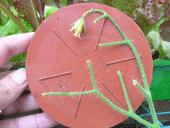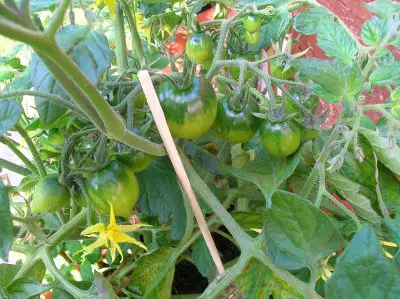More Stems Less Height
Today I would like to talk about an advanced pruning technique, for tall tomato plants and their suckers or side shoots, that may help those gardeners who don’t have the height available to grow tall varieties.
For example, have you ever grown a tall variety and found that it is getting too tall for the position it’s growing in? There are also wheelchair gardeners who find height an issue.
There is a way to make a tall variety more bush-like and that is to allow one or more of its side shoots, also known as suckers (I’m not referring to myself!) to grow instead of pinching them out.
This will result in several main stems (depending on how many side shoots you allow to grow).
The pic above shows a Sungold (tall variety) that had an accident and lost its main stem – I dropped a sheet of plastic on it!
I’ve allowed three side shoots to grow – one either side (as marked) and one behind. From each new side shoot stem, you then grow one or two trusses.
For example:
If I have one main stem and allow two side shoots to develop, I will end up with three stems.
I then grow one truss from each stem making a total of three trusses and hopefully end up with the same amount of tomatoes!
In a position where plant height is an issue, this is a way around the problem. I should mention that it is best to do this in the first part of the season (during June) as side shoots do take a while to grow and produce trusses.
For more on the subject of pruning tomatoes.
Flower/Fruit Set – Pollination
It is most frustrating to see tomato flowers die away without turning into pea-size fruit.
Tomato flowers contain both the male and female parts so all the action happens within a single flower. However, when flowers die away without being pollinated, the result is usually blossom drop – the whole flower and calyx (the green star it’s attached to) drops off the stem.
The usual advice is to mist flowers regularly and tap them to help the pollen fertilise the ovary, the female part within the flower, but there may be other reasons why tomato flowers aren’t setting.
Temperature
When temperatures drop below 10C at night, flowers won’t set. Some varieties will set at a slightly lower temperature than others and that’s one reason that helps make them early to mature.
Sunlight
It is also the case that if a plant doesn’t get enough sunlight, this can also prevent flower set.
The funny thing is, Brian is kept in the shade but is the first plant of the five Tumbling Toms to set fruit!
High humidity, damp air can effect pollen and stop it moving and fertilising the ovary within the flower.
Very dry air in hot conditions can turn pollen into dry dust and make it ineffective.
Conclusion
So what can we make of all this info?
Unless we have controlled conditions within a greenhouse where we can change humidity, light intensity and temperatures, we are at the mercy of the weather!
Well, we always knew that, and that’s what makes growing tomatoes such a challenge – to get successful results each season without the aid of expensive technology.
.
.
.
.
.
.
.
Feeding Tomatoes Tomato Food
Tomato food is usually given when the first pea-like fruit starts to appear – just after the flowers die away.
Red Alert (above) is good at setting its flowers at lower temperatures than many other varieties – that’s one reason why it is such an early variety to mature. Maskotka is close behind – see video below.
The Five Tumbling Toms
Brian is the first to set fruit (as mentioned above) and Charlie has also a tiny pea-like tom. Daisy is flowering well and because she gets lots of light at the top of the greenhouse, is not growing to high.
Alice is sprouting out all over and Eric is quietly content with all the water he’s getting – especially now that the sun is shining!
Leaf Curl – Bottom of Plant
This is quite normal and many varieties do this by default. These leaves will eventually be removed.
Leaf Curl Top
At this time of the season it is often the case that plants become stressed. Over/under watering, temperature fluctuations and becoming established in their final positions all take their toll. The result is often tightly curled top leaves and leaf branches curled under.
This condition usually rectifies itself over a week or two as plants adjust to their new conditions and temperatures become more consistent.
That’s it for this week, as always I’m happy to answer any questions if I can and you’ll find me on Facebook too.
Regards,
Nick




